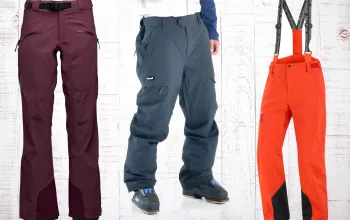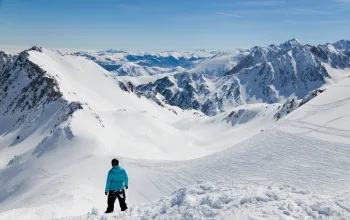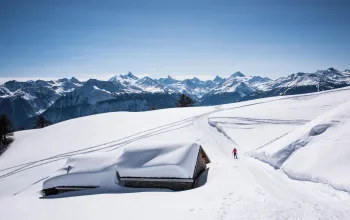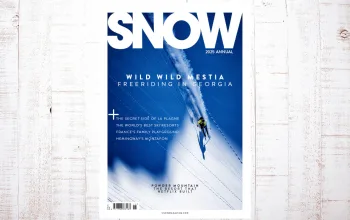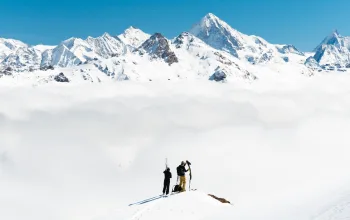"Knowledge is Powder" might be a horribly clichéd pun—the kind you see printed on University ski trip hoodies or cheap tourist t-shirts—but it's also kind of true. There's obviously a lot of luck involved involved in scoring epic conditions. No-one can control the weather. But you can stack the deck in your favour if you know exactly where to head when storms are rolling in.
Picking a resort that's high, with a healthy amount of north facing terrain, will up the odds. Resorts with smaller lift systems can also be a plus—your average intermediate skier usually wants miles of piste, with easy access, so smaller spots tend to attract fewer crowds. Somewhat counter-intuitively, this means that some of the resorts that are best for family ski holidays are also excellent for powder.
It's often wise to avoid anywhere with massive name recognition too. Chamonix has amazing off piste skiing, but everyone is chasing after it. Unless you're up at 3am and skinning up the mountain with your headtorch on, you're unlikely to find any untracked snow.
This list is far from exhaustive. But if off piste skiing is your thing, these ski resorts—and the backcountry terrain around them—are a great place to start.

Alagna, Italy
Alagna—which markets itself as "Alagna: Freeride Paradise"—is an amazing, little-known resort that hides in plain sight. It's one of the three areas that make up the massive, Monterosa Ski Area in Italy, and yet somehow manages to fly beneath the radar.
The village itself, Alagna-Valsesia, is small, with just a few hotels and eateries. It sits at 1,200m above sea level, so it's not especially high. But it offers access to some of the finest lift-served freeride terrain in Europe.
Three quick lifts take you up to a point called Indren, which at 3,275 meters is one of the highest lift stations in the Alps. From here, the options are almost unlimited—you can choose any number of itineraries back down towards the village, tour up towards the surrounding peaks, or head off into the wider Monterosa ski area.
It's often described as “Italy’s answer to Les Trois Vallées,” but attracts far fewer visitors than its French counterpart—which means fewer crowds, and more powder for you and your buddies.
Read our full ski resort review of the Monterosa ski area here.

Bonneval-sur-Arc, France
France might be most famous for its modern mega-resorts, but there are still a few corners of l'Hexagone where things feel a little more old-fashioned. Bonneval-sur-Arc, tucked away at the top of the Maurienne valley, is a case in point. In summer, this small cluster of stone shepherds' cottages is just a 45 minute drive away from Val d'Isère. But in winter, when the road over the Col d'Isèran pass shuts, you might as well be on a different planet.
The first lifts were built in Bonneval in the late 60s, but the village is far older, and with very few modern buildings, it's maintained a pleasantly sleepy vibe. Where Bonneval really comes into its own is the accessible off-piste.
The top lift takes you up to 3,000m, from where there are a whole host of classic itineraries to explore. The Maurienne valley boasts its own microclimate, a weather system called the Retour d’Est, which spirals up from the gulf of Genoa, and regularly plasters the mountains here, even when the more northerly ski resorts in France are missing out. Meanwhile, the lack of a huge freeride community means that, unlike Chamonix, say, you can still find first tracks several days after a dump.
Prices are cheap for France, especially when compared to those in Bonneval's upmarket neighbour, so it's small wonder that powder hounds from Val d'Isère often sneak over the closed col and snake their way down here. It's a three hour taxi ride back, but it's worth it to enjoy the untapped riches on a powder day.
Read our full resort review of Bonneval-sur-Arc here.

Grimentz, Switzerland
Nestled between two of Switzerland’s more famous ski destinations, Verbier to the west and Zermatt to the east, Grimentz enjoys similar consistent weather patterns, and high-altitude slopes, but gets just a fraction of the visitors.
Those that do come tend to split into two groups: families and weekend warriors, who want to cruise around the 115km of pistes, and serious powderhounds. Most of the ski area lies above 2,000 meters, making it snow-sure, and the off-piste terrain is incredible. There are several long, north-facing descents just a stone's throw from the major lifts, and these often hold fresh snow days or even weeks after a dump.
Switzerland isn’t known for being budget-friendly, but the prices for liftpasses, accommodation and food and drink in Grimentz are relatively reasonable by local standards. Which is definitely a bonus.
Snow magazine visited Grimentz in 2015, which you can read about here.
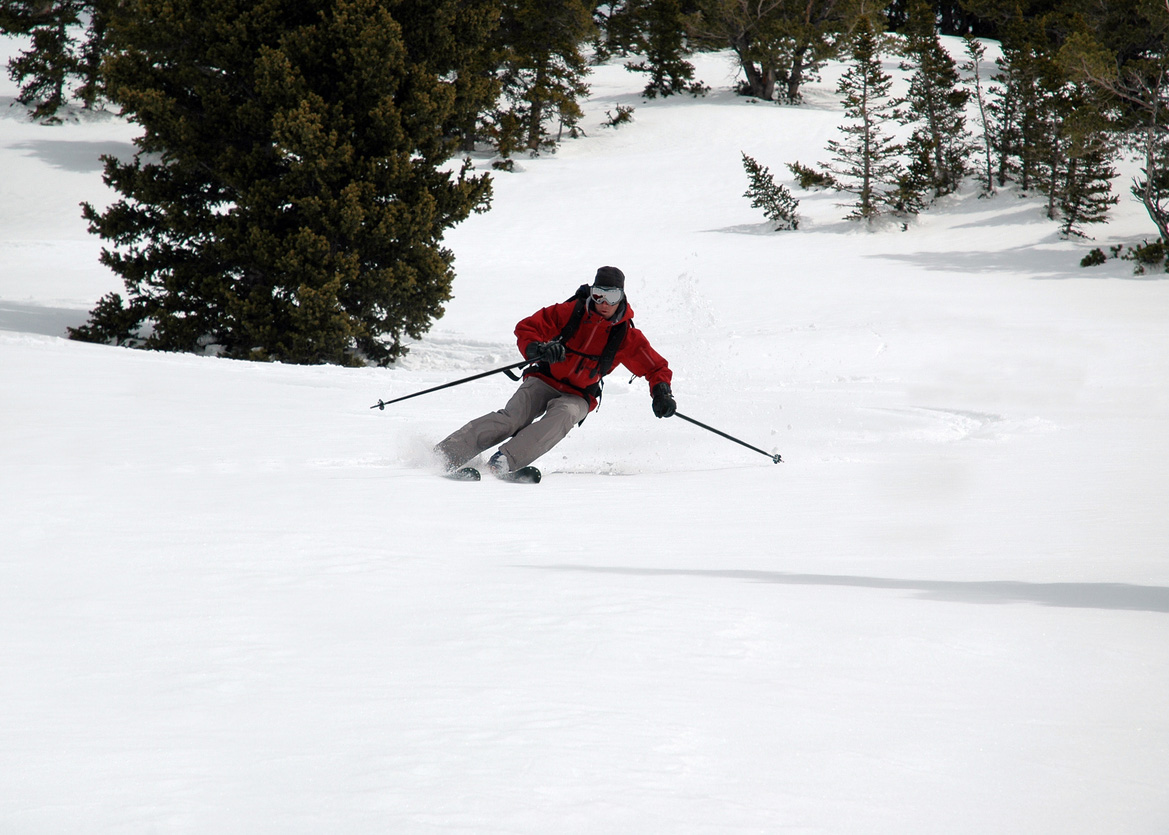
Powder Mountain, Utah, USA
The State of Utah famously claims to have "the best snow on Earth." If that's true, then arguably the best place to enjoy it as at Powder Mountain. The "resort" doesn't look like much. The base station is little more than a carpark, a guides' office housed in a yurt, and a saloon-style après ski bar call the Powder Keg.
Like most US resorts, the chairlifts are old and slow compared to the ones you find in Europe. But the way they're arranged in such a way as to offer access an impressive amount of terrain. Once you add in the snowcat tows that carry people up to some of the peaks, you have access to an incredible 8,484 acres (3,433 hectares). This makes it the largest ski area in North America by area—bigger even than Whistler-Blackcomb. And when deep snow falls, as it does with incredible reliability in Utah, powder mountain offers some of the best off piste skiing anywhere in the world.
For years, this was a locals' only spot. Most out-of-state visitors opted for the more famous Utah resorts like Park City, Brighton, or Snowbird. That began to change in the early 2010s when a group of tech investors bought it from the previous owner, who was retiring. Recently, it changed hands again, and Netflix co-founder Reed Hastings is now the owner. Plans are in place to update some of the older lifts and expand the skiable area, but Hastings has vowed to preserve the unique, laid-back vibe that makes the place special.

Tetnuldi, Georgia
Nestled between the towering 5,000-meter peaks of the Caucasus and the eastern shores of the Black Sea, Georgia’s Svaneti region has always been blessed with incredible snowfall. However, it’s only in the last 15 years that skiers have been able to fully take advantage of it. The Georgian government began developing the area in 2011 with the installation of new lifts in Hatsvali, near the ancient town of Mestia. By 2016, they had expanded further with a second set of lifts, on the mellow slopes beneath the 4,858-meter glaciated peak of Tetnuldi.
Named after the mountain, the resort of Tetnuldi only has about ten runs. But its real appeal lies in the vast backcountry accessible from its five lifts. In 2024, it was chosen to host the Freeride World Tour, and the pros competing were blown away by the riches on offer. Mestia has also seen growth, with a range of modern hotels and guesthouses catering to various tastes and budgets being built in recent years. Georgian mountain guides are also accredited the IFMGA - UIAGM standard, putting them on a par with their western European counterparts.
Despite these developments in infrastructure, the area retains its rugged frontier character. The roads are terrible, but that's part of the adventure. And the warmth of the welcome from the locals, plus the incredible Georgian cuisine, more than makes up for any difficulties you have in getting there.

Silverton, Colorado
Located in one of the most renowned skiing states in the U.S., Silverton has intentionally remained off the beaten path since its opening in 2002. The “resort,” such as it is, consists of a single chairlift that transports skiers to a ridge, where they can hike to access a variety of challenging, un-groomed runs. These runs all funnel into a central path that leads to a shuttle bus at the valley's end, ready to take you back for another lap.
Silverton limits the number of daily visitors, ensuring the slopes never feel crowded. Most skiers opt to ride with a guide, which helps the management "farm" the fresh snow after a dump — ensuring that no two groups ski the same line, and helping ensure there's fresh tracks for all.
The town is a former mining village, and has retained much of its original charm. While there are some modern touches, including posh, refurbished hotels and an award-winning craft rum distillery, the authentic wild west feel remains intact.








